Essentials on the what to pack list:
No 1: Waterproofs
First up on Julia’s walking holiday packing list are waterproofs. “Wherever you’re going, whatever your destination, pack your waterproofs,”
The trouble with planning a hiking vacation in Scotland is that you are almost spoiled for choice. There’s no way you will be able to fit everything in to one vacation.
The scenery on Skye and around the west coast of Scotland is remarkable from the road. It has inspired movies such as “Brave”. The draw is understandable but the disadvantage is that for Scotland it can be “touristy”. It will be unusually busy with other visitors. If you’re looking for a quiet experience of Skye when you have a chance to enjoy the scenery without the crowds, you’ll need to consider taking the time to explore there out of the main tourist season. April, May and September are the best times to head over there. You have a high chance of good weather and a low to non-existent chance of encountering the dreaded midges.
In recent years, particularly since the Land Reform Act (2003), there has been public money available to develop paths across Scotland. This has resulted in a proliferation of way marked long distance routes. The Land Reform Act (2003) formalised the right of access to all land in Scotland, whether privately or publicly owned. Access rights are for outdoor recreation, for crossing land and water, and for some educational and commercial purposes. Exercising access rights, and managing access land, must be done responsibly.
The most well-known of the long distance routes is the the West Highland Way, but there are many others like the Speyside Way (the one to do if you’re in to whisky). Another recently mapped route which is less formally organised is the Cape Wrath Trail. This trail is described by Cameron McNeish as: “It’s the sort of long distance route that most keen walkers dream of. A long tough trek through some of the most majestic, remote and stunningly beautiful landscape you could dare imagine.” You can research more details here: http://www.capewrathtrail.co.uk/foreward.htm There is also a recently published map by Harvey maps covering the area involved.
A full list of long distance paths across Scotland is available here:http://walkhighlands.co.uk/long-distance-routes.shtml They range in length from 338km to 38km. Some can be linked together to make a longer route.
The disadvantage, depending on your point of view, of most long distance paths in Scotland is though they go through mountainous areas most if not all of these routes do not go up the mountains so if you stick to the waymarked route you’ll only be admiring the peaks from afar.
Photo Caption: Long distance path walking in Scotland
There has been quite a lot of investment in path construction and signage in Scotland since the development of the Outdoor Access Code in 2002. There are opportunities virtually everywhere to get out of the car and explore a wee bit to a viewpoint or through spectacular woodlands or around a loch etc. The difficulty is in knowing which option to choose.
WalkHighlands can help with this in that all the walks they list are graded and have an estimated length in distance and time. However, possibly the best way of choosing is to ask your hosts at your accommodation for their recommendation of the best walk to choose and if you have a wee bit more time available take advantage of a guided walk as you will gain so much more insight into the area from the guide’s knowledge. There are ranger guided walks in most areas, particularly in the National Parks like the Cairngorms and the Trossachs which will reduce the cost. Some of these walks are even free. Boat of Garten has it’s own ranger service offering guided walks around the woods behind the village. The RSPB also offer guided walks on the Abernethy reserve.
The advantage of booking a walk with a guide is that you’ll be able to get off the beaten track with confidence. You might even be able to do a longer walk or go higher than you would be confident doing on your own.
A guide will also have extensive knowledge of the local folklore, the environment, the flora and fauna as well as the terrain through which you are hiking. There really is nothing better for bringing the area alive to you. As a student or cash strapped tourist you may consider the cost relatively high. However when you look at the cost of eating in a restaurant or your accommodation for the night, you’ll realise that on an hourly rate your guide is not charging a lot of money. A qualified mountain leader will have invested years of training into his qualification not to mention the cost of the training course itself.
A qualified mountain leader (or accompagnateur) will charge from £150 – £200 for a day out. This fee will be split across the clients in the group. The larger your group of family the less the cost per individual. The rewards of going out with a guide for the day are however beyond price as you will learn so much more about the area which you won’t find in the guidebooks.
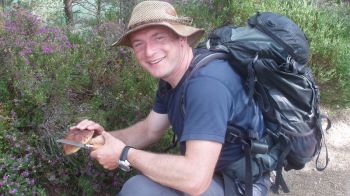
Most organised hiking tours will explore only one area in depth. While this approach is not for everyone (many people visit a country with a tick list of sights they want to visit – which are inevitably the same spots 90% of visitors also want to see, resulting in overcrowding), if you go on an organised vacation you are often more likely to have a more genuine and authentic experience of the country you are visiting.
It is worth checking that the company you book with has a philosophy which appeals to you. Also that the structure of the trip suits your priorities. For example, if you are thinking of booking with Scot Mountain Holidays but it is important to you to have 5 star hotel style accommodation, rather than a home away from home, you will probably look elsewhere for your trip. The philosophy behind our vacations is that our guests stay within our home. They immerse themselves in the atmosphere and feel comfortable discussing all aspects of life in Scotland.
Of course, if you have enough time you could consider a shorter, organised trip as part of your vacation and tour the rest of the country by car/bus.
Think about access – a major consideration as part of the planning. Some areas of the Highlands are more difficult to reach than others. For our organised vacations we have tried to make it as easy as possible for our guest to access them. We offer pick ups from Aviemore station and Inverness airport. In the Cairngorms, we are lucky enough to be near the major route north from Edinburgh – the A9, which makes it very efficient to get here.
It may look like it isn’t far to reach some areas of the Highlands but travelling on narrow, sometimes single track roads, will take longer than anticipated.
When planning your trip bear in mind that reaching some areas by public transport can be time-consuming. Many of the routes used have to go around rather than through the mountains.
Julia Bradbury recently published her tips on what to pack for walking holidays in the Express. We thought we’d compare our packing lists. Let’s have a look at Julia’s top picks.
This is not by any means intended to be a comprehensive kit list. Don’t use it to pack for your next walking break, but we just wanted to highlight one or two things which have been essential on our own trips plus have a quick look at items we’d consider non-essential/luxury items as we think it’s essential to have something in your pack which gives you some additional pleasure at the end of the day.
First up on Julia’s walking holiday packing list are waterproofs. “Wherever you’re going, whatever your destination, pack your waterproofs,”
It seems obvious to an experienced walker that you should always pack your waterproofs, particularly if you are an experienced walker in the UK. You expect the weather to change. However, if most of your walking has been done in a continental climate, you might be forgiven for expecting the weather to be consistent. On our recent holiday in the Sierra Nevada (Spain), we did meet some hikers (even on the highest peak, Mulhacen, at over 3000m) who set out without waterproofs.
Lack of suitable clothing could cause you to have to turn back from your objective.
Be a scout when it comes to a hiking vacation and “be prepared”.

Julia also emphasises the importance of good walking boots – and you might want to consider investing in more than one pair.
“Make sure you’ve got the right kind of boots for the terrain you’re going to be walking through,”
“If you’re going for a boot that will suit all walks then an ankle boot is vital,” she said.
It might seem obvious to talk about boots for a walking trip, but not everyone thinks to pack walking boots. There are many who think that trainers will do. There are also extensive discussions and debates online in various walking/hiking forums as to the benefits and disadvantages of boots versus walking shoes. Those who have opinions either way are quite vociferous about the benefits on their side of the argument.
The most important thing is that your feet are comfortable.
Uncomfortable feet is the worst experience you could have if you’re committed to a hiking vacation. Feet can be uncomfortable in different ways but in our experience along with boots an essential item to pack is foot cream.
Another option is approach shoes which are becoming more popular. These are good for rough track terrain but not for steep inclines.
She added: “It’s good to have them in your backpack if you get your boots wet or you cross a river or your feet get wet for whatever reason.”
A second pair of footwear is in our opinion essential to the comfort of your feet. The last thing you want to do after a day out hiking in your main boots is to put them back on to go out in the evening
You must look after your feet as they are bearing the burden all day and to keep going you need to pamper them.
WHERE WE START TO DISAGREE
A more surprising item Julia likes to take is a tinted lip balm. “It gives you sun protection and a splash of colour on the lips as well.”
are also a must for a walking holiday, said Julia.
The walking enthusiast also advises taking a single strap rucksack, and weighing scales.
We’d have to agree with Julia’s top 2 picks. It seems really obvious to pack your boots and waterproofs if you’re heading off for a walking holiday (particularly if your destination is Scotland) but believe me sometimes people leave out the water/windproofs if they think they’re heading off to a warm destination, but if you’re going mountain walking anywhere you should always be prepared for the weather to turn.
On our recent trip to Spain there were other walkers who were caught out by the weather turning on Mulhacen. We all walked up in glorious sunshine, but woke up to drizzle. The higher up the mountain we went, the windier and colder it became. Those without waterproofs really suffered in the wind.
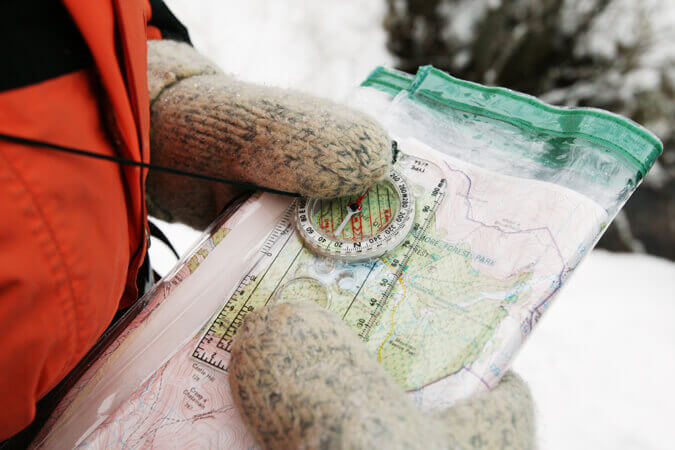
Dachstein mitts don’t necessarily mean that you won’t be able to use a compass or to navigate, as shown by our director Andy Bateman
For the other 3 items – are they really necessary? Are there other more important things you should make sure you have first?
Our top tips to you personally would be:
bring a map and if you have one a GPS &/or compass
Even on a guided trip it is useful to have your own map. These days you can quite easily get digital mapping on your phone. Personally we don’t like to rely on this as we don’t have the most up-to-date phones and the screen size can be really irritating. It is useful to be able to enlarge portions of the map though, especially as your eyes start to find the small print a bit more of a strain. However, if you’re going to rely on digital images, make sure you have an extra power pack for your phone. Personally this would rank higher up on our own list than flipflops or lip balm.
Because we can’t go on holiday in the main summer season (a dream for the future maybe), and therefore we are almost always away in October, we always pack gloves and hat. If you’re travelling in the main part of the summer season we’d recommend always packing a sunhat and sunscreen (even in Scotland) but not necessarily a midge net. Check our blog on how to have a midge free vacation
Be sure to have at least one item for yourself which you would consider a luxury (a bit like Desert Island Discs).
Our luxury items include:
a book/kindle
a knitting project
a teddy (perhaps only a consideration for the youngest member of your group)
chocolate
your favourite hiking snack which you buy at home
tea (for the British audience) or your favourite coffee
But don’t forget to leave a wee bit of space (if you can) for souvenirs!
What would your luxury item be?
Fancy a guided walking holiday in November? Not a question you hear every day.
One of the most frequent questions we are asked is: how do you cope with the short days in winter? Scotland is not Finland though. We never get 24 hour darkness. Actually it’s the long days of summer which make more of an impact. The shorter days of winter really don’t last that long.
The disadvantage of hiking in Scotland in November is that the day light hours are short though we still haven’t reached the shortest day of the year, so if you’re wanting to do a Munro hike it might be best to book a guide. At the very least, you’ll need to make sure you have a functioning head torch in your pack.
When you go travelling the memories which stick with you are the unusual situations, or the times when you’ve done something different. These chances almost always happen when you meet new people. They give you new advice, or show you something you wouldn’t otherwise have experienced.
Get off the beaten track with us combines at least one guided day with the opportunity to explore on your own following our personally designed routes. When you take up the guided day as part of the “Get Off the Beaten Track” choice, you’ll be opening up an insider’s knowledge. You still get the opportunity to explore independently, but the trip will be so much more memorable and the day on your own so much more enjoyable. “Get Off the Beaten Track” is a safe way to be adventurous and get away from the crowds.
Ben Nevis sees thousands of people plodding up to the summit every year in everything from flipflops to full on winter hiking boots or skis purely because it is the highest peak in the UK.
Ben Macdui, the second highest peak, is a lot less busy. As with all Scottish peaks, care always needs to be taken as it is the weather conditions and the speed with which they can alter, which makes these summits dangerous, rather than their height. Many Europeans are very scathing about the Scottish”Mountains”looking purely at their height in order to assess them and claiming that they can’t really be mountains when they are less than 2000m in height. Look at the Alps they say. Look at the Pyrenees. Those are real mountains. In Scotland, though the mountains themselves are lower in altitude, the climatic conditions are as violent at they can be at 2000 or 3000m in the Alps. Hence, taking a guide to explore across the Cairngorms is sensible thing to do if you are not familiar with the area.
Bear in mind is that there is little waymarking of routes on the high plateau in Scotland. This is yet another way the Scottish mountains differ from Europe. Historically the land has been owned privately here. Waymarked routes have not been developed across the high mountains.
There is a system of networked paths at lower levels and there has been a lot of work in recent years to improve the paths for hikers; a knowledge of navigation is still required for mountain hiking.
The joy of hike in the Cairngorms is to take it to the “brink” – the edge of the plateau where the views down the steep glacial features of places like the Loch A’an amphitheatre are breathtaking. Andy has hiked in the Cairngorms for close to twenty years. He knows the hidden highlights, the history, the plants, the quiet spots where you’re more likely to see unexpected wildlife, where you might bump into the Cairngorm reindeer herd; but even he is always discovering new plants and seeing unexpected wildlife every time he heads out.
On the second day, we’ve put together a shorter route on Cairngorm – but as you can see from the photos below, despite the fact that it is very accessible, you’ll hardly be in the crowds!
Autumn hiking opportunities for everyone
Soft light of autumn combined with mist to produce excellent photography opportunities
Put together a list of the Munros you want to bag this autumn. We’ll make sure you get to tick them off your list – if humanly possible in your timescale.
We can offer:
This package can also be adapted to take advantage of the sleeper service from London to Aviemore station.
Please contact us for a quote or to discuss options with Andy.
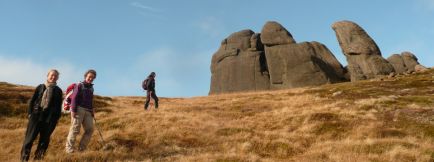
Highlights: Glenlivet whisky, ascent of Ben Rinnes , iconic Scottish wildlife (pine marten and red squirrels).
Hiking, whisky & wildlife – this trip samples the crowning glories of the Cairngorms National Park.
We’re not heading out to bag the highest peaks on this trip; instead we’re bagging some of the top icons of the Scotland’s persona – whisky, wildlife, and the added bonus of some stunning scenery. There’s more to Speyside than whisky, but equally there’s more to whisky than most people are aware. Andy knows all the low-down. (Check out our “how to choose a connoisseur’s whisky” blog).
There was a time that the whisky industry was an illicit trade for smugglers. There was also a time that the wearing of tartan was illegal. All that changed when Queen Victoria made the Cairngorms a venue of first choice for summer vacations.
We won’t quite be hiking in the manner of Queen Victoria, in long skirts, with sedan chairs to take the strain, but we’ll certainly be covering some of the ground the royals enjoy when we’re on the Royal Glenlivet Estate.
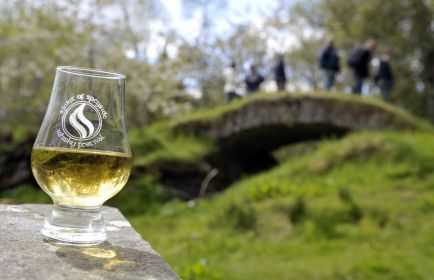
Email us if you think we can help plan your vacation in Scotland – we can hit all the Highland hotspots and include some off the beaten track surprises you might not know about.
For inspiration check out our Pinterest board and our Flickr account.
We are frequently asked what to pack for a day hike in the Highlands, usually by our guests preparing for their guided walking tour with us. People often ponder on whether they should pack shorts, a sun hat, sunscreen. What gloves to bring etc – the list goes on.
Bear in mind, that if you are planning to head out on your own or at least without a guide, then you will also need to pack the following gear and be familiar with how to use it.
map & compass: you will need a good quality, local, walking map such as Harveys or Ordnance Survey (we stock the 1:50,000 OS map for our area). Do not rely on your mobile phone mapping.
You should also always pack some food (even small snacks) and some water. It is possible to refill your water bottle along the route, but take care if you are following a low level popular path. If there is a lot of livestock in the area, it would be best not to refill your bottle unless you have a water purifier with you.
Always tempting if you happen to strike the good weather to whip out the shorts to go for a hike. It is however worth bearing in mind that Scotland is not without its pests. There are ticks in Scotland which hang on the undergrowth, particularly at low levels waiting for someone or something to come past. Ticks are often carried by deer who rub them off on the vegetation. The ticks wait there for the next host to continue their life cycle. They can wait for years.
If you do pick up a tick it is not the end of the world. There is Lymes Disease in the UK which can be treated with antibiotics – but early removal of the tick is key to the prevention of the disease. We have tick removers here at Fraoch Lodge. Make sure you check yourself over at the end of the day. However, you can minimise the risk of picking up a tick by wearing long trousers and gaiters over the top of your boots. Generally speaking dog walkers and golfers are often at more risk than hikers of returning with ticks.
Unless you’re going to be battling through particularly overgrown parts of the countryside, the length of your sleeves is not too vital and the rate at which you get cold will determine whether you think long or short sleeves suitable for the day.
There are not many well graded, smooth paths in the Scottish hills. Most tracks are relatively rough with loose stones and rocks. It is usually sensible to use over the ankle walking boots to protect your ankles from turning and also to keep your feet as dry as possible. Leather boots, though heavier, should provide the best protection and will be generally more waterproof than gortex lined fabric boots.
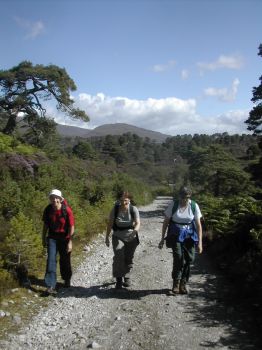
Waterproof shell jackets are by far the most popular. Most shops stock a wide range of jackets designed with gortex fabric. Andy himself prefers to wear Paramo clothing or Cioch direct waterproofs. Both these companies use the same material. Cioch Direct specialise in made to measure clothing. The advantage that the Nikwax analogue material has over gortex is that it is designed to be reproofed after washing so is likely to last you longer. The jackets can also be returned for repairs at little or no cost. The disadvantage is that the material is heavier and can prove to be too warm in the height of the summer – though at an average year round temperature of 0oC, the Paramo jackets are usually suitable for the Cairngorm plateau.
Always useful to include a warm hat and gloves at the bottom of your pack as it can be cool on the hill tops even in August.
The most sensible attitude to your clothing for hiking is to make sure you have several light layers which will provide maximum flexibility rather than one or 2 choices. Make sure that your layers are not cotton options as you could cool off very rapidly, should your cotton layer become damp whereas synthetic or wool layers will either dry more rapidly or stop you from cooling down too much.
The most useful size of packpack to bring with you is a 35 litre pack. This will be large enough to take all excess clothing, camera, packed lunch etc. Smaller than this may mean that you have to limit what you take on the hill, particularly in winter.
Wandering into the Cairngorms
Please don’t hesitate to contact us if you have any queries about the clothing/gear you are intending to bring with you for your Scottish vacation.
If you’d like to book a guide for your day hike, please don’t hesitate to get in touch with us. Andy is extremely knowledgeable about the Highlands of Scotland from history to nature and everything in between. A hike with him is an introduction to everything you wanted to know.
Email: info at scotmountainholidays.com
Tel: +44 1479 831 331
Are you planning to visit Scotland for self guided walking holidays? There are some important factors which should influence your planning.
Just because you don’t consider the hills in Scotland to be mountains by the standards of your country, doesn’t mean that you shouldn’t treat the routes with respect. Remember when you do your planning that a lot of routes are not way marked. Our experience of hiking in Europe is that most of the routes are signposted and marked with paint on the rocks and/or trees. Don’t expect this to be the case in Scotland, unless you are following an official long distance path like the West Highland Way.
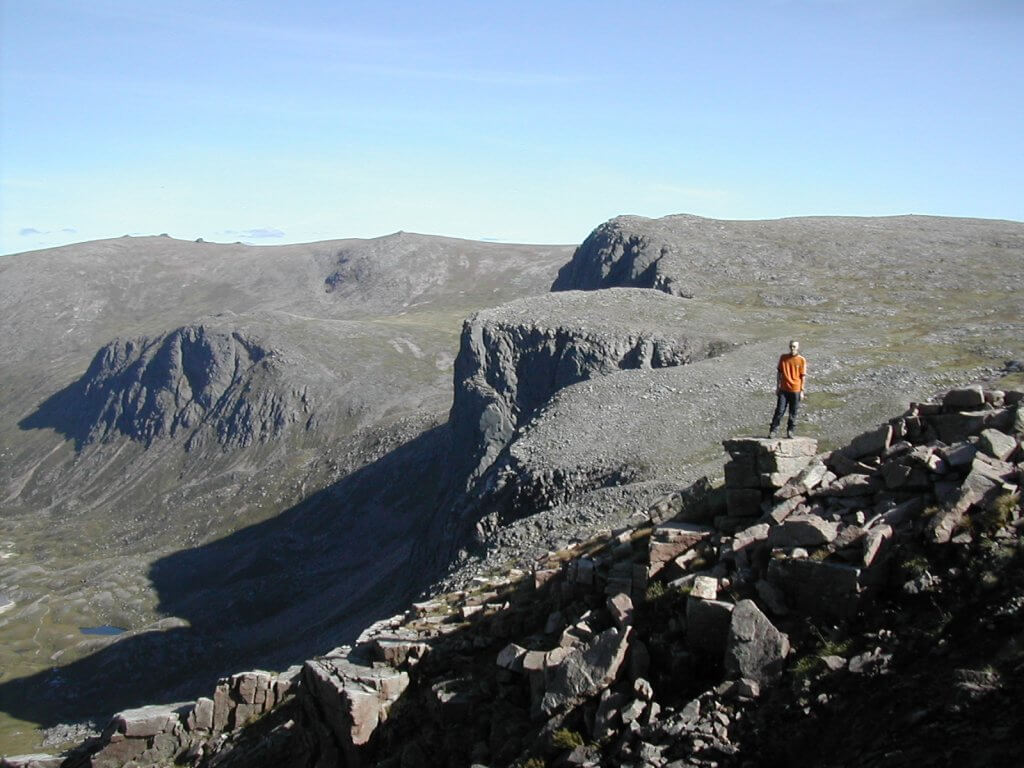
Deep in the Cairngorms National park. What a view!
The locals are the ones who will know if bridges have been washed away; if the streams are running high and you need to be careful with the river crossings; when there is tree felling going on; if the paths have been diverted; or in winter, particular avalanche hazards
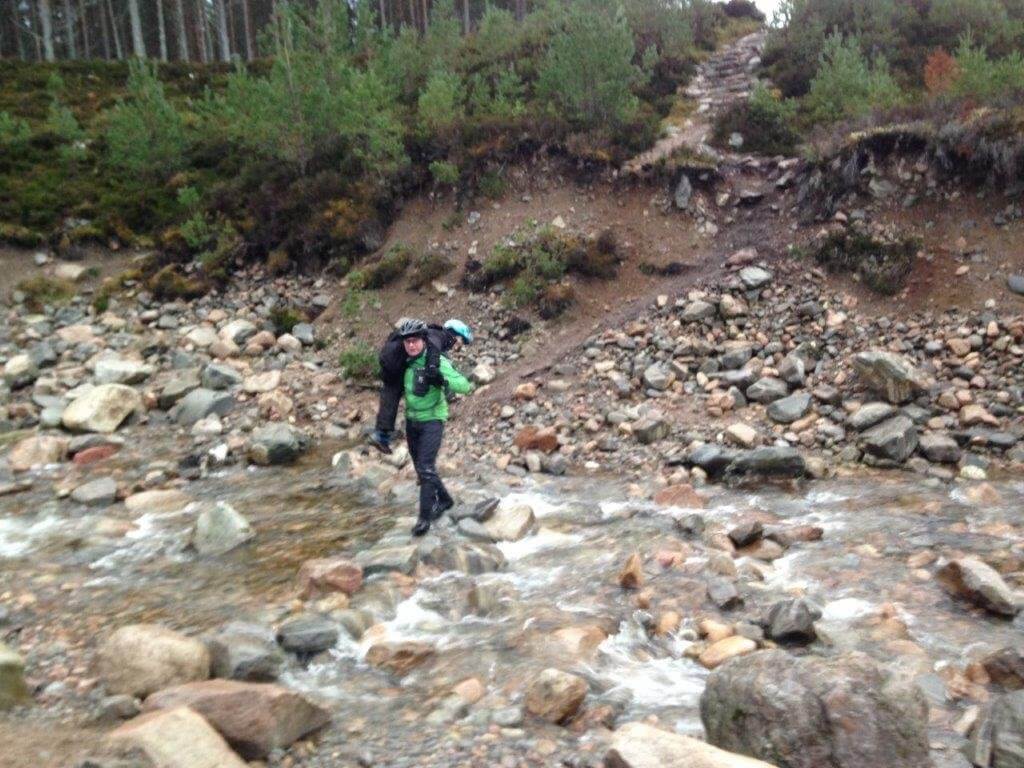
The river in Glen Feshie has undergone some serious flooding causing parts of the path to collapse and the river to change its path
– if not, then be sure to take a refresher before you head into the higher level terrain.
Our maps are very good but you will need a proper map for hill/mountain hiking. Look for either Ordnance survey or Harvey’s maps. You can use Viewranger to plan your routes but do not expect to navigate by digital maps in the hills. Your battery could die and the screen is not big enough. Don’t worry though – if you’re based at Fraoch Lodge and haven’t had time to pick up a local map, we do stock them. We also have mountain bike specialised maps for select routes around the Cairngorms.
If you’re not sure of your navigational skills
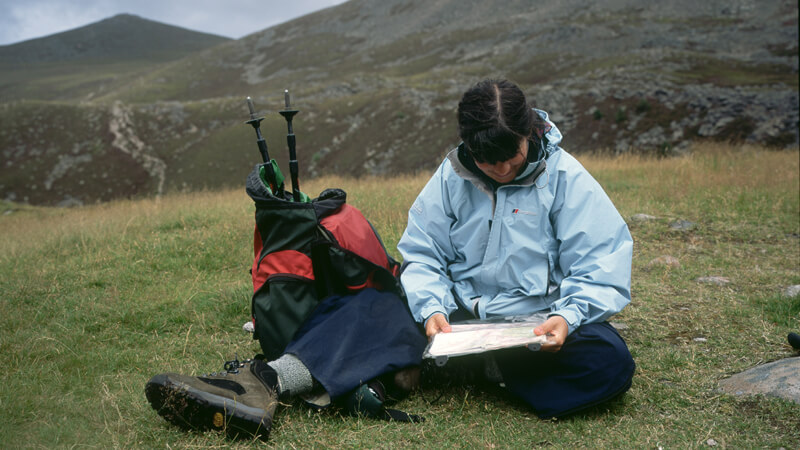
A female walker seen sitting down resting and studying her map, wearing her boots and waterproof clothing, with her rusksack and walking poles, Cairngorm Mountains, Scotland.
Model Release
Photograph by David Mansell 07831 559901 mobile
There is a reason why Scottish people talk about the weather so much and if you hear someone talk about 3 or 4 seasons in one day – that means that the weather will be changeable on a daily/minute-by-minute basis.
When we say you should have a water/wind proof jacket, we don’t mean a cape. In our windy conditions you need a jacket which fits your body and won’t catch in the wind. If you’re looking for a new jacket or waterproof pants/trousers, we highly recommend the following Scottish companies: Cioch direct – for made to measure nikwax analog outer layers or Findra – for quality, eco-friendly outdoor clothing
– which is also shared with our guests on the organised self-guided walks
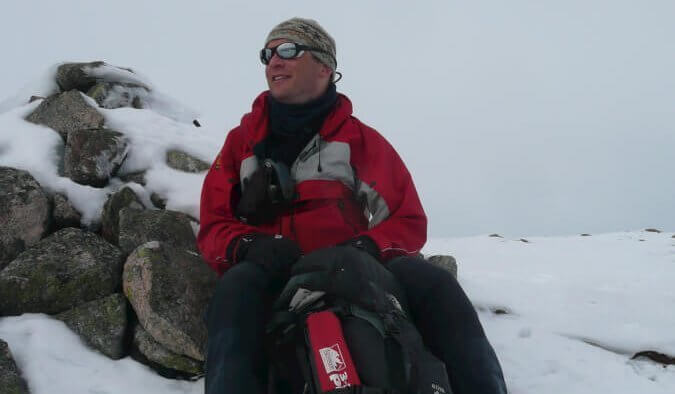
It is really important to make sure that your feet are comfortable. The smallest blister or hotspot can ruin your hiking plans. You’ve probably brought over your normal comfortable hiking shoes/boots but haven’t made allowances for the rough terrain you could be walking through. Just make sure you keep an eye on your feet. Pamper them if necessary. There are now plenty of excellent artisan soaps and hand/body creams available throughout Scotland. We highly recommend Highland Soaps, Arran aromatics or the Soap Bothy. Highland Soaps do a bog mrytle scented lotion/soap which has the added bonus of being repellent to midges!
This is particularly important if you are attempting a long hike like the Lairig Ghru
If you take long, undisciplined breaks then the end of the day is just going to keep disappearing into the distance. If you don’t take enough breaks, then you’ll become more tired than you should be and might find the walk very disheartening.
Our recommendation is to walk for about 80 minutes before taking a 10 minute break when you make sure to eat some of your picnic/snacks and take a healthy drink. Be disciplined with your breaks on longer hikes. At the end of the day it will make for a much more enjoyable experience.
This relates to the 4 seasons in one day weather we have here in the Highlands. You never quite know what you’re going to encounter during the day, even if you have religiously checked the forecast. Andy recommends: in summer, dress cool (relatively – light trousers/pants rather than shorts) on the legs), and warmer on top, as it is easier to regulate your temperature by putting on or taking off a fleece/jacket than removing long johns when you get too hot. In winter, dress warm on the legs.
Midges in Scotland have a reputation which far outweighs their size, but perhaps not their numbers.
Here in Scotland, we’re not subtle in our campaign to drive the visitors away. We emphasise the rain and then we start with the midge stories. And still people want to come. Well we’ve come up with a plan for you. We’re going to try and make sure you go back home without mentioning midge horror stories and without any stories of being drenched by rain. Our plan: visit the east.
In the Highlands of Scotland, particularly in the Cairngorms, we can have an early frost in September or a late frost in May. Midges can’t survive a frost. If you arrive in Scotland, before the weather has warmed up too much you are unlikely to see many midges. Also if you visit in May or early September, you are also likely to encounter the best weather conditions Scotland has to offer. May 2018 (and June) have been exceptional in sunlight terms, but there is also now an increasing issue with the swarms of midges. Over on the west coast, it can be difficult to find builders at this time of year. Their work requires that they remain stationary or at least around the same site for extended periods of time, and the midges just won’t leave them alone. However, direct sunlight and windy conditions do mean that there are few if any midges around.
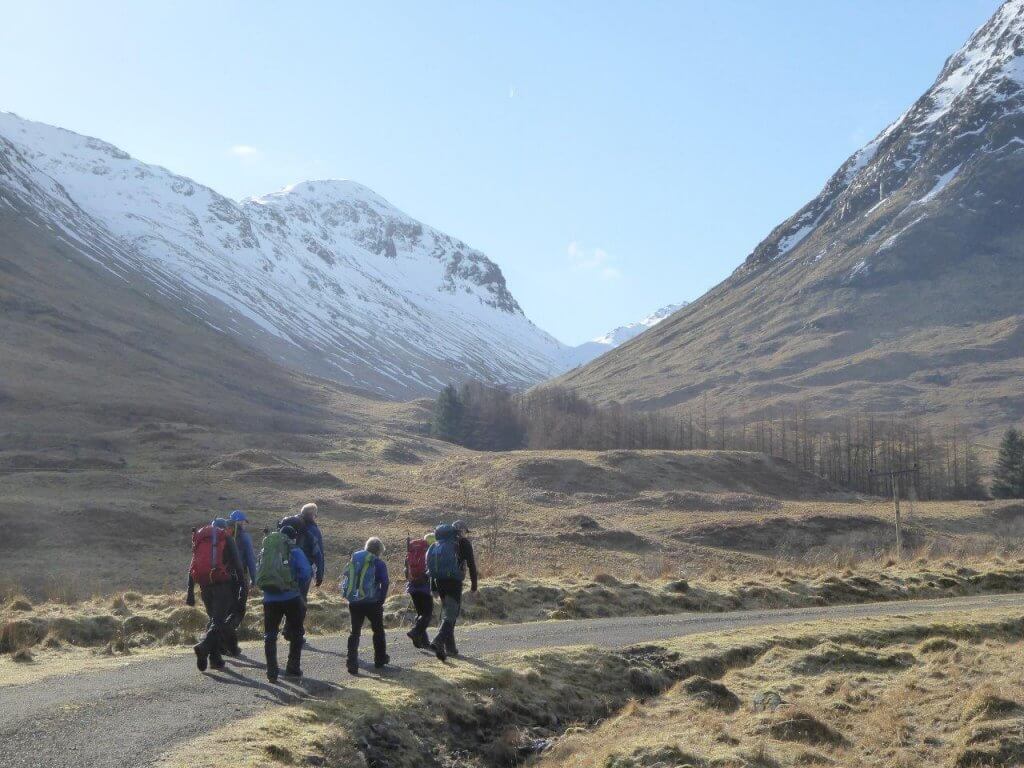
This photo was taken in Glencoe in March. This is when you can really enjoy hiking in the area. There is still snow on the ground, so it is not for the faint-hearted but there are no midges in Scotland and the air clarity is amazing. Perfect for photography.
We plan all our west coast walking holidays around both the best weather conditions and the height of the midge season. We rarely if ever, go to the west of Scotland between June and the end of August.
We have our home base in Boat of Garten in the Cairngorms National Park for a number of reasons. High on the list is the lack of midges, in general. On a still, damp morning/evening, you definitely become aware of their presence in season, but more often than not we rarely encounter them. They can be a bother in the Cairngorms, but the drier weather here and the sometimes windy conditions, keep the levels of midge down to manageable levels.
Midges in Scotland do love damp forest conditions though as the trees provide them with shelter from the wind and the sun, so be careful if you picnic in the woods.
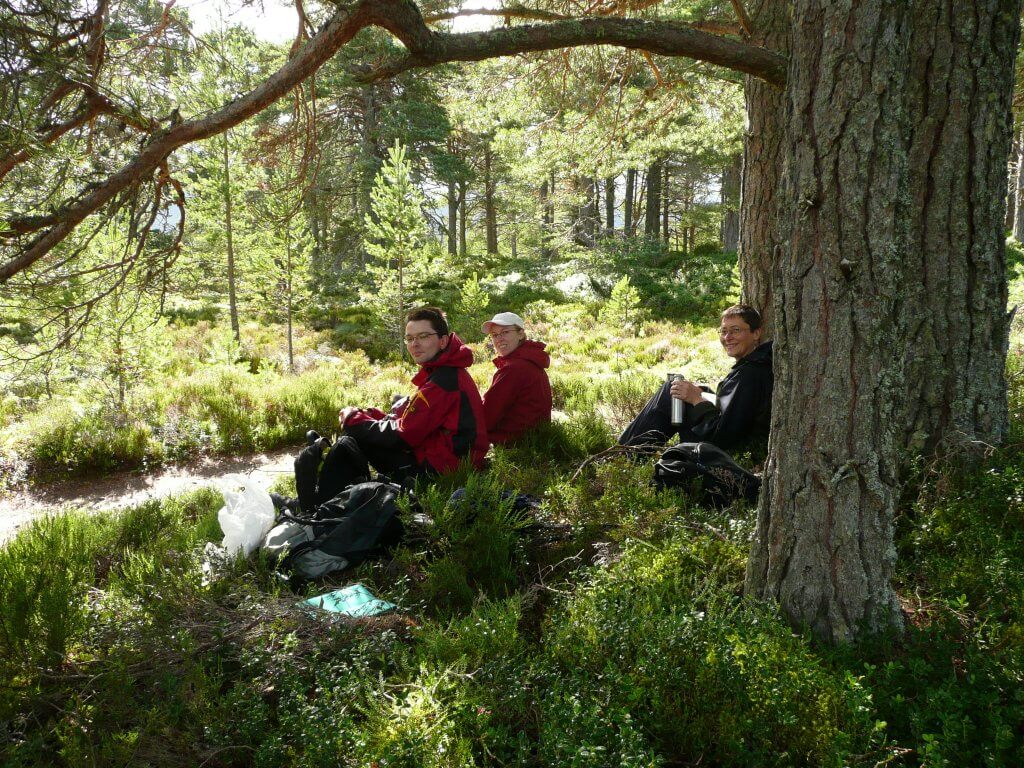
Relaxing in the shelter of the trees – beware the midges on a wind free day.
On still, damp days our best advice would be to engage in something high speed (eg mountain biking or road biking or zip lining) which will keep the midges away from you as you generate your own “wind” ie slip stream. You’ll be moving too fast for them to keep up.
Failing something high adrenaline you could just admire the scenery from the seclusion of your car, being sure to insulate yourself from the outdoors with your air conditioning system or alternatively indulge yourself in a bit of culture or city life for the day.
There are plenty of museums you can visit, even in the Highlands. Or try a castle or distillery.
We recommend the following distillery tours:
Tomatin (especially if you have under-18s in your party)
Glenlivet (regular tours which are translated into most major European languages)
Glenfarclas (a more unique and family atmosphere than other distilleries)
Aberlour (highly regarded and recommended to us)
Or try to Speyside Cooperage – a unique opportunity to see the traditional coopers at work making and refurbishing the casks which are a vital part of the whisky industry.
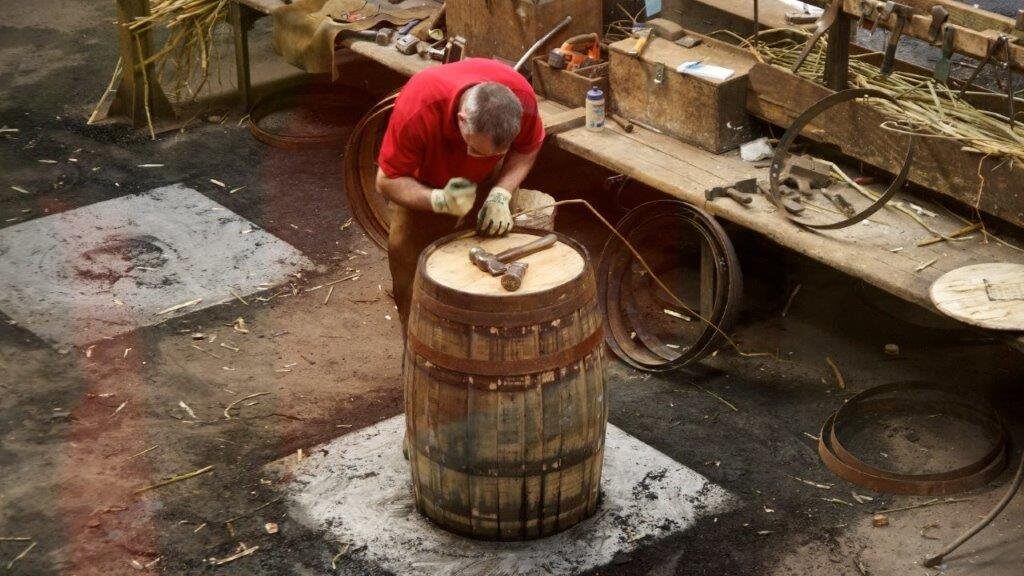
A cooper hard at work repairing casks at the Speyside Cooperage
Midges are so tiny that they can’t tolerate any more than a very light breeze. There is a fine balance in how much wind you can enjoy before it starts to affect your enjoyment of your day out, but hopefully you will find there is a strong enough breeze to keep the midges away, but not too strong to prevent you from enjoying your hike. The strength of wind you can tolerate yourself will depend on your experience and body mass. If the wind is starting to push you around, you’ll stop enjoying your day out and be concentrating too much on trying to maintain a straight line to your destination.
This is probably the hardest one to do if this is your dream vacation to Scotland. Almost everyone has at least one west coast destination on their itinerary, usually Skye. Stock up on plenty of repellent if you’re heading over between June and mid-September.
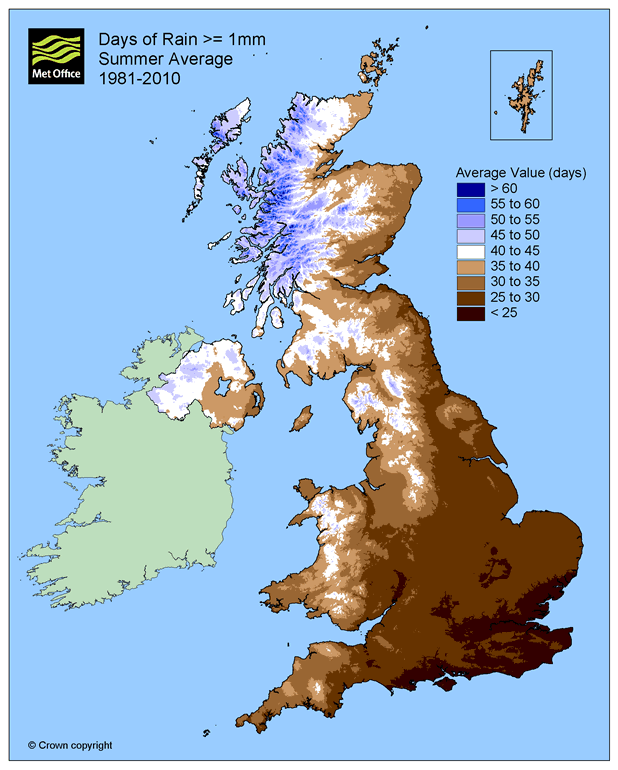
This is relatively easy advice to follow in early summer as dawn takes place so early and dusk so late, but by August it is worth being aware of the sunrise and sunset times.
If you’re planning an active vacation in Scotland, it’s worth checking out our programme as we have planned to include the best of the weather and the best of the midge free opportunities across the Highlands. We can also plan a tailor-made trip for you. If you base yourself with us we have good access to most other areas of the Highlands (except Skye and the Outer Hebrides) and can make the most of the best weather where ever it is.
Other precautions you can take:
For a light-hearted summary take a look at the video below:
There’s no getting away from the fact that if you visit Scotland in the summer you will quickly find out that there are midges in Scotland. If you go hiking in Canada and parts of the US, you need to carry bear spray with you. We don’t have any pests on the same scale as that, but you have no doubt heard about the Scottish midge. It seems to be a scary prospect for a large number of people intending to come and visit Scotland. They can be of plaque proportions sometimes but over here in the dry East of Scotland, we really don’t suffer from swarms of midges at all.
If you’re concerned about the prospect of midges bear the following tips in mind:
Midge facts from the makers of Smidge – a repellent which works.
2. Use repellent, naturally based if possible as deet is not kind to the skin. (A chemical which will melt a plastic bag is surely not designed to be used on the skin repeatedly over an extended period?)
3. Purchase a midge net
4. Use citronella, lavender or bog myrtle candles – preferably in a well-ventilated place or outdoors.
You’ll find that a midge bite from midges in Scotland is itchy and annoying but doesn’t have any long lasting effects. It won’t have any impact on your health long-term. The real pest to be wary of is the tick. I don’t hear anywhere near as much discussion about ticks from visitors planning to come to Scotland, but there is a risk that you should be aware of. Ticks don’t just bite dogs. They don’t just affect hill walkers – in fact, you can be at risk of a tick bite on a dog walk or playing golf.
Midge solutions
[amazon_link asins=’B01EJF6LAE,B00413715E,B002MDAOSQ,B06XKKS2JX’ template=’ProductCarousel’ store=’1603-8102-0783′ marketplace=’UK’ link_id=’1d95a286-6f07-11e8-889b-abcc7d60ddfc’]
Most of the west coast including Skye, Torridon and Arran.
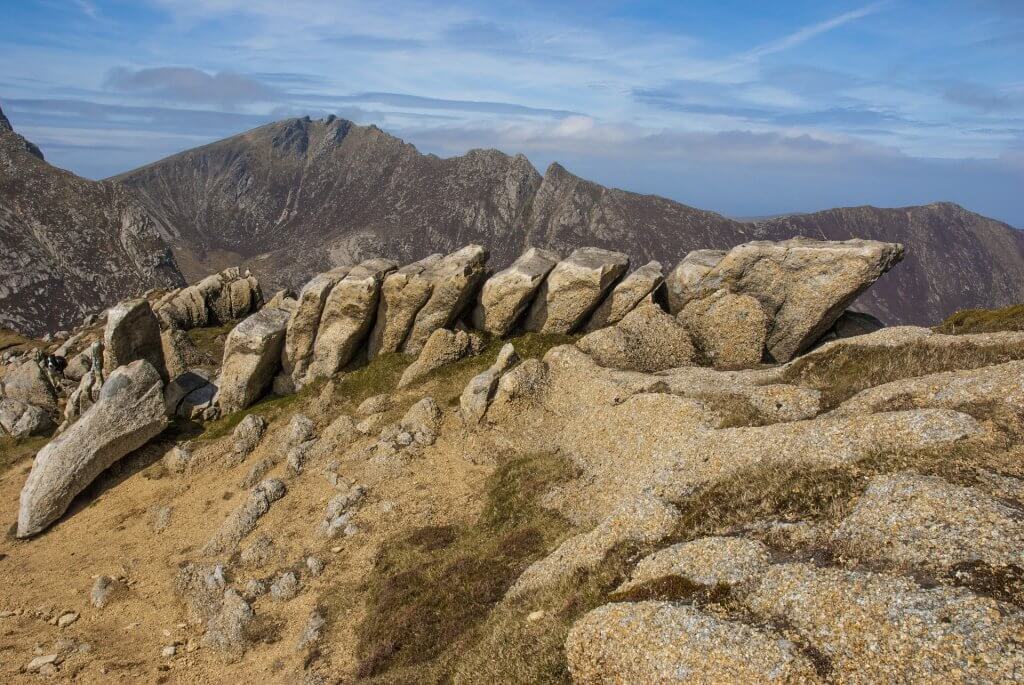
The peaks of Arran
We camped on Arran one year to check out some new routes we were planning to offer our clients. Found the perfect spot to wild camp, set up the tent, (nice breeze blowing all the while). Woke up, unzipped the tent and rapidly zipped it up again. At some point in the night, the breeze stopped and the midge clouds arrived.
You’re most at risk of tick bites if you venture off the main path and brush against any undergrowth as this is where the ticks like to hang out.
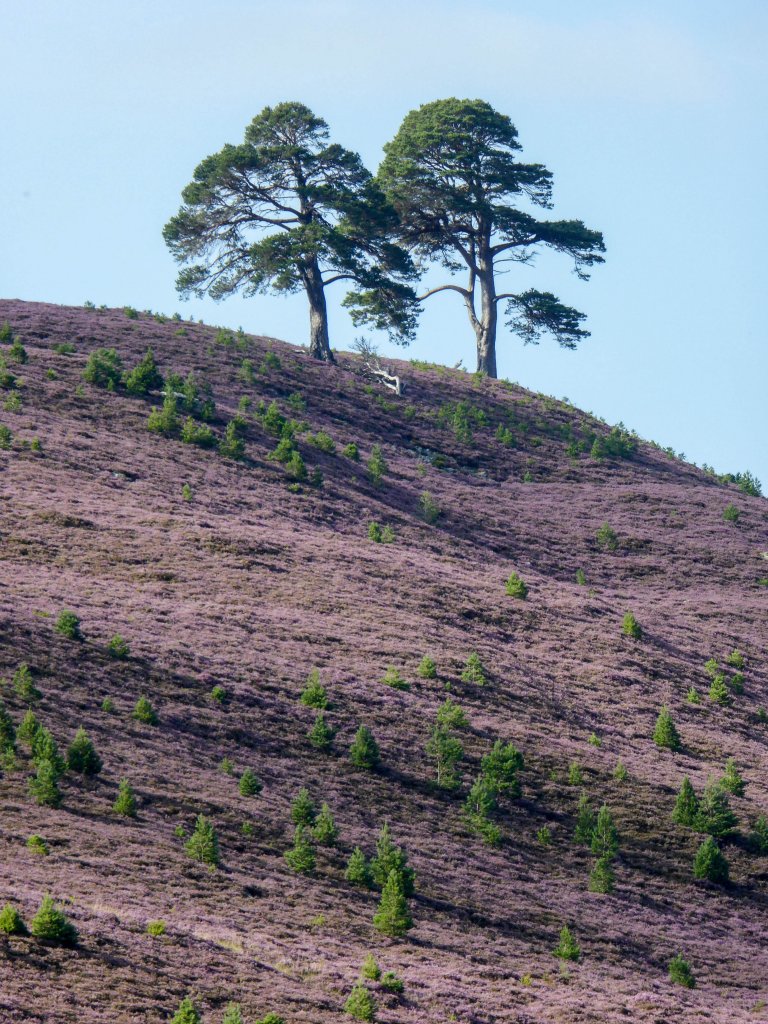
Most Scottish hill walkers are aware of the risk of Lyme disease and do check for ticks when they shower at the end of the day. Some of them can be so tiny that they are very difficult to spot. You pick them up from the undergrowth, just as dogs do. They can hang from the under side of ferns for years waiting for a host to come along. They don’t fly, but they will crawl on you until they find a spot they find warm and dark to attach to you. The most common places to find them are behind your knees, in your groin, or if you’re female, around your boobs.
A tick bite won’t be painful when it attaches to you and it will fall off on its own if left. Once it has finished it’s blood meal. However, it is definitely a good idea to remove it as soon as you can to reduce the risk of Lyme Disease.
Do not just pull a tick off if you find one attached to you. My personal early warning system is that I find a tick bite very itchy, worse (per bite) than a midge bite. If you just pull a tick you risk leaving it’s head attached to you. Also if you squeeze it while detaching it from you, you can force it to regurgitate it’s stomach contents into your bloodstream which will increase the risk of Lyme’s disease.
Tick twisters
[amazon_link asins=’B0037DD27U,B072JXRRBQ’ template=’ProductCarousel’ store=’1603-8102-0783′ marketplace=’UK’ link_id=’278ba43b-6f06-11e8-bce5-0727019eda1e’]
Tick lasso
[amazon_link asins=’B001QC34LS’ template=’ProductCarousel’ store=’1603-8102-0783′ marketplace=’UK’ link_id=’32301992-6f06-11e8-87f8-41d3dad923df’]
Tick map and predictions for the future
We rarely see swarms of midges on our guided hiking holidays.
There are midge hotspots in the Cairngorms, but it really is nothing like the west coast. Linn of Dee can be a wee bit midge infested if you’re hanging around before setting off into the Lairig Ghru, and if you’re at Corrour Bothy in the evening, you’ll possibly see a fair few – but we rarely have to put off our gardening. If we had more time to enjoy the garden we could without being bothered by midges.
When it comes to planning an adventure holiday, we often overlook the hidden gems of the UK. Here in Scotland plenty of adventure is on offer;
Whether this is your first adventure holiday or you’re an avid explorer, you need to make sure you have the right travel insurance. Making sure you have the right travel insurance will ensure you are able to enjoy your trip. You’ll have peace of mind that should the worst happen – you will be covered.
Many believe travel insurance is solely for overseas holidays. Unfortunately even in the UK there’s still a chance you may need to cancel the trip or return home early. The cost of a UK adventure holiday can soon add up; what with the travel expenses, accommodation, food expenses and excursions. You’ll want to make sure you protect that investment.
The guys over at Travel Insurance Explained understand how tricky it can be to understand the jargon of the travel insurance industry. They have given us some key points to look out for when buying a suitable adventure holiday policy.
Most policies will offer cover for pre-booked UK holidays of two nights or more. Usually these include cover for cancellation, medical expenses and personal possessions as standard.
TIP: When selecting your policy, make sure the cover level is suitable. If you have paid £1000 per person for your holiday, then the cover level should match this. If you chose a policy with an inadequate level of cover you could find yourself out of pocket. Should you need to make a claim most insurers will only pay up to the stated cover level.
So, how about covering the activities? Under standard travel insurance a select number of activities will be covered, and most policies will allow you to add on those that are slightly more dangerous for an additional premium.
It is important to note; most policies will have a height restriction on certain activities. For example, mountaineering up to 1000m may be covered as standard; however, climbing higher could require an additional premium. Likewise, leisure cycling may be covered but off-road biking may not. Always check with your tour guide to make sure you are aware of the heights and activities you will be participating in and if you are unsure, call your travel insurance provider to clarify the right level of cover.
Generally speaking, standard travel insurance policies will not offer cover for sports equipment. Having said that, there are more specialist sports travel insurance policies available or you could simply look for a company which offers a ‘sports equipment extension’ for an additional premium.
If this is something that is not offered by your policy either look for one that will cover this or check your personal possession cover on your home insurance. We always recommend checking your policy wording carefully to make sure you are buying a policy that covers all your needs.
Once the travel insurance is out the way, you are free to enjoy your break and truly get your teeth stuck into some adventure – enjoy!
When you have a very limited amount of holiday time, it’s very difficult to make choices for your time in Scotland without spending a lot of time in a car/bus/train as you’ll no doubt want to do everything the guide book recommends. Every different district in Scotland is busy promoting itself as “THE must-see destination”. No doubt you’ll want to spend some time in Edinburgh. A lot of people put Skye very high up the list. If you’re American, St. Andrew’s will no doubt be up there near the top of the list too and if you’re a first time visitor Loch Ness will probably be somewhere near the top too. How on earth are you going to fit it all in to your schedule?
Your first option of course is to consider one of the many minibus tours of Scotland, which will promise to take you to all the top sites and also deliver “off-the-beaten” track extras. They’ll reserve accommodation for you and suggest places to eat, but watch out. The quoted price is usually just for the bus tour and doesn’t include accommodation, meals or entry fees into the various places of interest. When you’re budgeting for one of these tours, make sure you take into account the extra expenses you will have to incur.
Many of these tours, particularly Rabbies, will also promise you some opportunities to get out of the bus and walk a wee bit. Most of these walks are very short (around 2 hours) and are generally in very scenic but popular places like Loch an Eilean (in the Cairngorms) or the Fairy Pools (on Skye).
Do you truly want to be part of a crowd? Another option is to hire a car and research an efficient route around the places you want to see. Try not to double back on yourself. See if you can find a suitable circular route. Visit Scotland have developed quite a few suggested itineraries on their site which are free to download and usually follow various themes so you should be able to find one which fits in with your interests.
We can offer self-drive itineraries. Please bear in mind that we are always going to recommend that you spend some time with us here in the Cairngorms National Park. We believe it is by far and away the best area to base yourself when exploring the Highlands.
Self-drive tours are a great way to go as you can be completely independent. You are able to get to all those out of the way places which are inaccessible on public transport. The disadvantage is that they can be very time-consuming to plan and if you don’t know the country you could make mistakes which cost you time-wise. Don’t forget to allow a relatively significant budget for fuel on top of the hire and activities you’ve planned.
A tailor-made itinerary with Scot Mountain Holidays doesn’t have to be too expensive. Don’t forget if you’re making comparisons that we provide a complete service. You won’t have to allow extra in your budget for additional meals or accommodation or activities. We’ll look after everything for you. Usually our prices include everything except alcohol from when we pick you up to when we drop you off. We can make adaptations to suit you and your party but our trips aim to provide you with a unique experience of Scotland not a package off the shelf.
Sometimes we do take our guests to the more popular tourist sights, like Loch Ness. If we didn’t include places like this, we wouldn’t get any enquiries. Usually however, these visits are not the most memorable parts of the visit. Sometimes guests are marginally disappointed by their day out with the rest of the tourists. One couple we worked with spent a week with us: they went hiking with Andy; they went out on mountain bikes exploring the forest and picking mushrooms; they went on the Zip wire in Aviemore and they went to Loch Ness (as on their itinerary). Their visit to Loch Ness was nowhere near as high on their list of memories as their day out with Andy in whisky country where they didn’t see another tourist all day.
Our hiking adventures are also aimed at providing all our guests with unique experiences so we avoid the hotspots other companies list as “off-the-beaten track” or as the French say “hors de sentiers battus” as in our opinion Glen Coe and the Old Man of Storr on Skye are not off the beaten track at all. We’d take you to places you’ve probably not heard of as below.
Hiking will be the focus of the trip and not visiting the popular tourist sights. You’ll certainly go home with a unique experience which will have involved all your senses: taste, touch, smell, hearing and sight. Memories created involving all your senses last longer and create more stories to share with your friends. No queues and no crowds!
Hikers descending from a long day’s hike in the Assynt area (Scotland)
There are lots of ways to explore Scotland from minibus or coach tours to hiking adventures. The method you choose will depend on your own personal priorities and who’s to say that you can’t come back and try another kind of experience the next time. We’ve certainly had some guests whose first experience of Scotland was a minibus tour round the highlights, but they’ve chosen to return and explore in greater depth with us as the bus tour merely whetted their appetite to see more.
Walking route options and choices
Planning a hiking holiday in Scotland (but not the West Highland Way)
Where to walk in the Highlands
If you’re into walking and hiking you’ll probably consider a walking holiday at some point. Once you’ve decided that you’d like to go hiking, your next consideration will be the destination. Depending on where your home is, walking holidays in Scotland could come quite high up the list of possibilities. Scotland has all the usual hiking advantages. When you add in the reasons for ranking Scotland over and above other destinations around the world, then you may well find yourself visiting Scotland in the near future.
It goes without saying that Scotland is a stunning country and the Highlands in particular are gorgeous, but why pick any of the walking holidays in Scotland? There are so many thousands of other destinations around the world which you could choose.
Scotland has world beating access legislation. There is no law of trespass here, so long as you are not on someone’s grounds or garden. Obviously you need to be responsible. It is not acceptable to disturb livestock or leave rubbish behind you. You are expected to “Leave No Trace” or in other words “Take nothing but photos, leave nothing but footsteps.” However, in return you can wonder at will across the landscape and do not need to stick to defined footpaths.
Access to the high hill tops in the UK has developed very differently in Scotland than in Europe. In Europe, there has always been a strong tradition of taking livestock to the high alps for summer pasture, but the land was not privately owned. In Scotland, vast tracts of land belong to private estates but the high land is not considered particularly valuable. It is not good pasture and is not very fertile. Common access has always been taken for granted and until the Land Reform Act was published the lack of a trespass law and the responsibility of landowner and land user were not clearly defined. Now responsible access is everybody’s right, but the key to this is to act responsibly.
Private land ownership in Scotland has meant that there are not a lot of waymarked paths across the high hills.
 Amazing panoramic view across the high peaks of the Cairngorms which could be yours during walking holidays in Scotland (Taken by Claire Grogan on a guided winter walking holiday with Scot Mountain Holidays
Amazing panoramic view across the high peaks of the Cairngorms which could be yours during walking holidays in Scotland (Taken by Claire Grogan on a guided winter walking holiday with Scot Mountain Holidays
If you are considering walking holidays in Scotland, bear in mind that freedom of access also means freedom from signage and waymarked paths.
Much as the world may sneer at our mountains, thinking them just bumps on the landscape; while they do not reach the towering heights of Everest, they should still not be taken lightly. The decided advantage to mountains of lesser stature, however, is that though you can have spectacular views and expend a significant amount of energy climbing up them, you will not suffer the detrimental side-effect of altitude sickness.
No large predators –
The bear and the wolf etc have all been extinct in Scotland for some time. If you are very lucky you may encounter a shy adder sun bathing on a mountain slope, but they are rare and not usually deadly. So no poisonous snakes or spiders either. We like to keep our irritating pests small and inconvenient: the tick and the midge!
Compact –
Scotland’s hills are nice and compact. You can have an amazing adventure in a day if you so wish. Then you can still return to partake of your home comforts at the end of the day. You can also – if it becomes necessary – travel a relatively short distance (up to 2 hours) and experience a completely different day’s weather than you can see from your kitchen/lounge window.
For example, Andy once had a private guiding booking from a group of ladies staying in a cottage in Glen Feshie. When the day dawned, it was raining steadily. Andy drove over to meet the clients – who were showing a distinct lack of enthusiasm for heading out. He persuaded them to give the walk a try and drove from Glen Feshie round to Ben Vraikie, near Pitlochry. On Ben Vraikie there was no rain and the hill top was clear. It may even have been sunny. Whereas back at home base it was one of those dreich days of rain and grey light all day. Know your weather patterns and you can still have a good day out.
There are such a wide range of options in Scotland, even if you only visit the Highlands, that you’re spoilt for choice. Before you start to choose your hike, you need to decide which parameters are most important to you.
There are famous viewpoints to discover; lochs to circumnavigate; historic sights to see; Munros (282 in total) to climb; Corbetts to climb, Grahams to ascend and Marilyns to collate. Where do you start to choose?
Remember though that hiking and mountaineering are hazardous activities by their nature and you have to accept an element of risk yourself if you choose to enter the mountain environment without a guide. The weather in Scotland changes in an instant. Even if the day looks calm and sunny when you set out, it could end up a completely different season by the end of the day. Please make sure you are well-equipped (see our suggested kit list for ideas). Check out our blog on gearing up for the autumn
Always check yourself over for ticks at the end of the day, particularly if you have been walking through rough undergrowth.
Make sure you pack some Smidge.
Check out our walking holidays in Scotland
All content © Copyright Scot Mountain Holidays 2025
Responsive web design by Summit Web Solutions